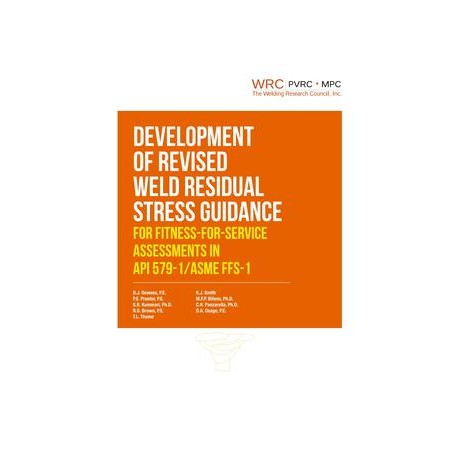No products
 View larger
View larger
Development of Revised Weld Residual Stress Guidance for Fitness-For-Service Assessment in API-579-1/ASME-FFS-1
M00002278
New product
Development of Revised Weld Residual Stress Guidance for Fitness-For-Service Assessment in API-579-1/ASME-FFS-1
Book by Welding Research Council, 2015
D.J. Dewees, P.E., P.E. Prueter, P.E., S.R. Kummari, Ph.D., T.L. Thome, K.J. Smith
In stock
More info
Full Description
Understanding the residual stresses associated with welds in pressure vessels, piping, and other structures is an essential part of designing reliable equipment in the petrochemical, chemical, and nuclear industries, among others.
In recent years, the evolution of parallel computing technology, and overall improvements in computer performance have made detailed computational weld residual stress analysis feasible.
Furthermore, recent enhancements of commercial finite element software programs have enabled the implementation of complex weld simulation techniques.
The intent of this WRC publication is to document the work relating to a recent investigation into the current (2007 Edition) API 579-1/ASME FFS-1 Fitness-For-Service (API-579) guidance pertaining to weld residual stresses.
This work was sponsored by the Materials Properties Council (MPC) Fitness-For-Service (FFS) Joint Industry Program (JIP).
The primary goal of this study is to simplify, enhance, and reduce any undue conservatism associated with the API-579 weld residual stress guidance provided in the current Annex E.
Explicit computational weld residual stress simulation is employed to compare results against experimental weld residual stress data obtained primarily from the published European NeT benchmarks.
Additionally, a comprehensive review of existing guidance in API 579 and current European standards is provided.
This review of existing guidance includes consideration for the effects of heat input and ultimately comparison of through-wall weld residual stress distributions for different weld geometries.The thermal-mechanical finite element-based results presented in this publication show excellent agreement with published experimental data and provide a foundation for understanding the methodologies and nuances associated with accurately simulating the heat transfer and ensuing non-uniform plastic strains from the welding process.
In particular, a discussion on non-linear material modeling techniques, including formulations for implementing cyclic plasticity, is presented, and a comparison between isotropic, kinematic, and combined hardening material models is rendered.
Commentary on the differences between two dimensional and three dimensional simulation approaches is considered to be especially useful.
In this publication, the authors present the underlying analyses and background information used to update the weld residual stress guidance in API-579, and a complete summary of this updated guidance is provided herein.Finally, the content of this WRC publication was made possible through the financial support of the sponsors for the MPC FFS Joint industry Program.
Additionally, the significant effort required to generate this publication is realized, and the support provided byThe Equity Engineering Group, Inc. and The Babcock Wilcox Company is acknowledged.
This study represents the basis for significant improvements to the current recommended weld residual stress analysis techniques, including verification and validation procedures, and provides sufficient background and benchmarking to permit utilization of explicit weld residual stress simulation, if the analyst so choses.

